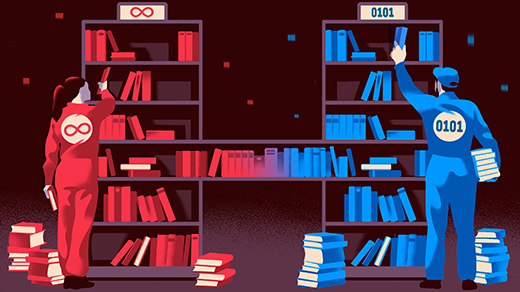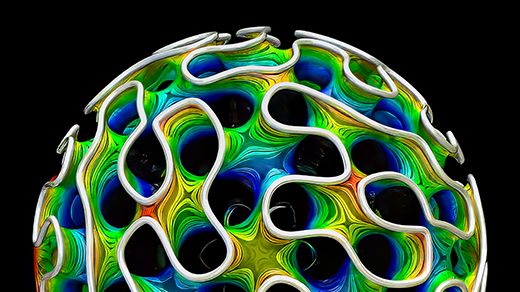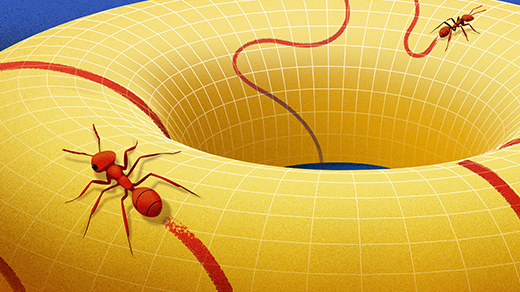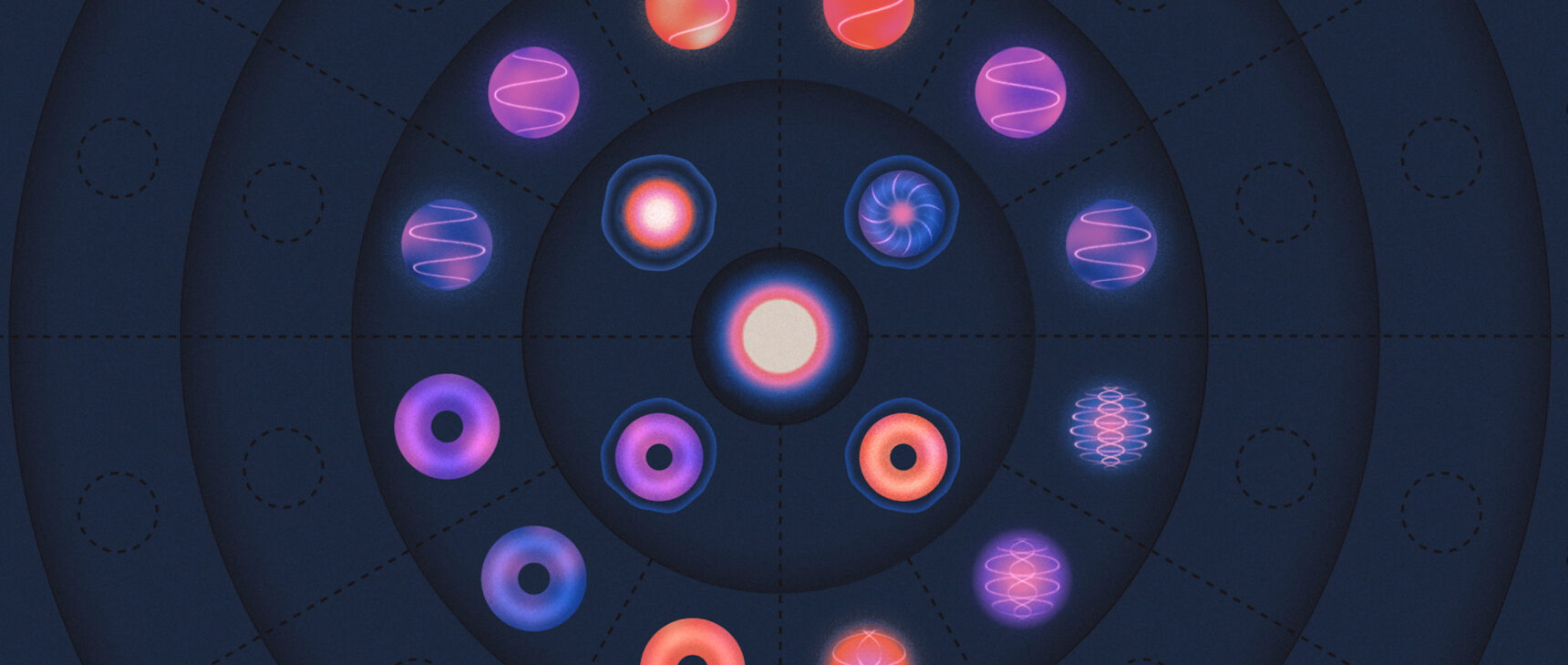New Shape Opens ‘Wormhole’ Between Numbers and Geometry
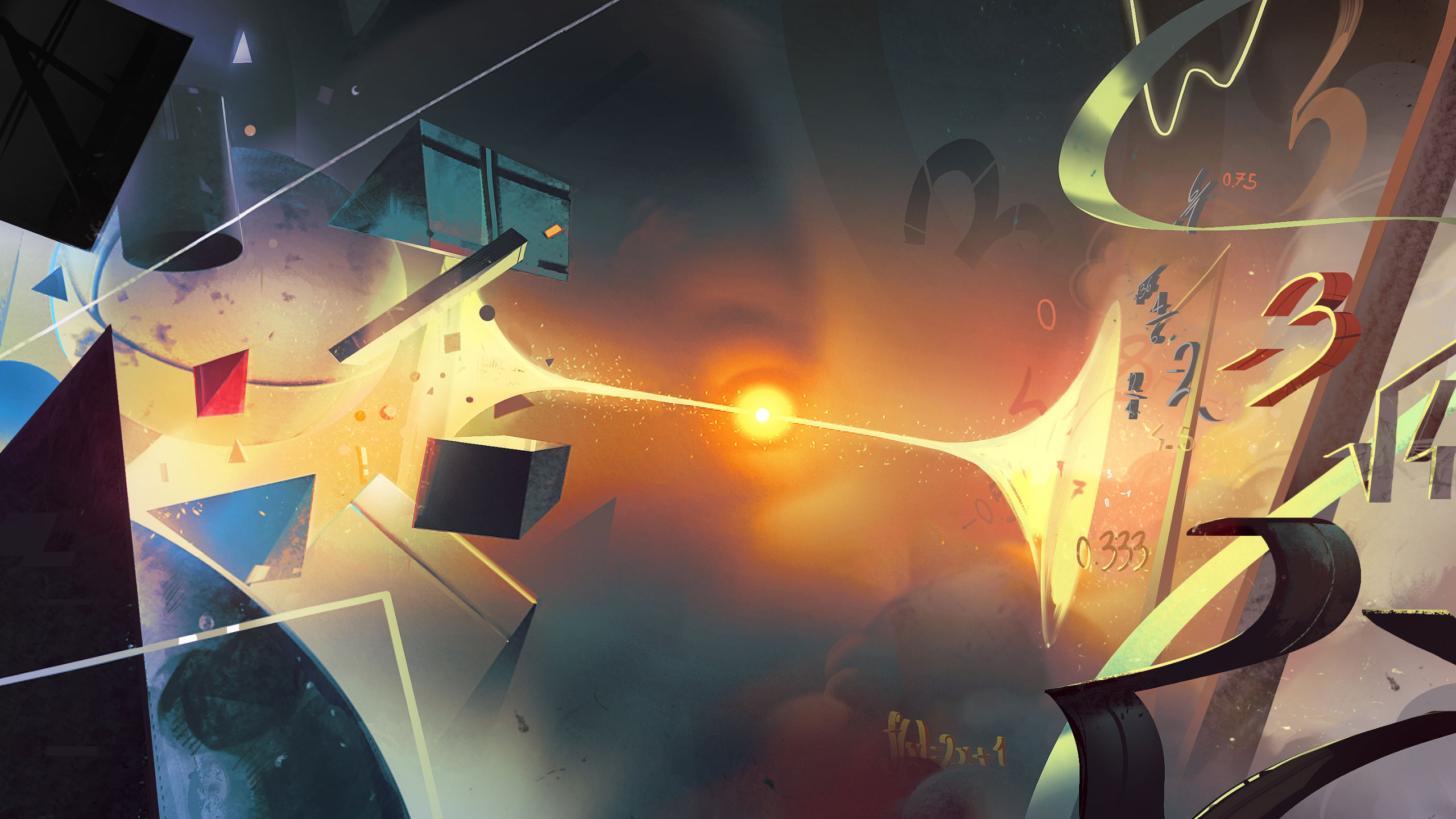
Matteo Bassini for Quanta Magazine; spots by Olena Shmahalo/Quanta Magazine
Introduction
The grandest project in mathematics has received a rare gift, in the form of a mammoth 350-page paper posted in February that will change the way researchers around the world investigate some of the field’s deepest questions. The work fashions a new geometric object that fulfills a bold, once fanciful dream about the relationship between geometry and numbers.
“This truly opens up a tremendous amount of possibilities. Their methods and constructions are so new they’re just waiting to be explored,” said Tasho Kaletha of the University of Michigan.
The work is a collaboration between Laurent Fargues of the Institute of Mathematics of Jussieu in Paris and Peter Scholze of the University of Bonn. It opens a new front in the long-running “Langlands program,” which seeks to link disparate branches of mathematics — like calculus and geometry — to answer some of the most fundamental questions about numbers.
Their paper realizes that vision, giving mathematicians an entirely new way of thinking about questions that have inspired and confounded them for centuries.
At the center of Fargues and Scholze’s work is a revitalized geometric object called the Fargues-Fontaine curve. It was first developed around 2010 by Fargues and Jean-Marc Fontaine, who was a professor at Paris-Sud University until he died of cancer in 2019. After a decade, the curve is only now achieving its highest form.
“Back then they knew the Fargues-Fontaine curve was something interesting and important, but they didn’t understand in which ways,” said Eva Viehmann of the Technical University of Munich.
The curve might have remained confined to the technical corner of mathematics where it was invented, but in 2014 events involving Fargues and Scholze propelled it to the center of the field. Over the next seven years they worked out the foundational details needed to adapt Fargues’ curve to Scholze’s theory. The final result doesn’t so much bridge numbers and geometry as collapse the ground between them.
“It’s some kind of wormhole between two different worlds,” said Scholze. “They really just become the same thing somehow through a different lens.”
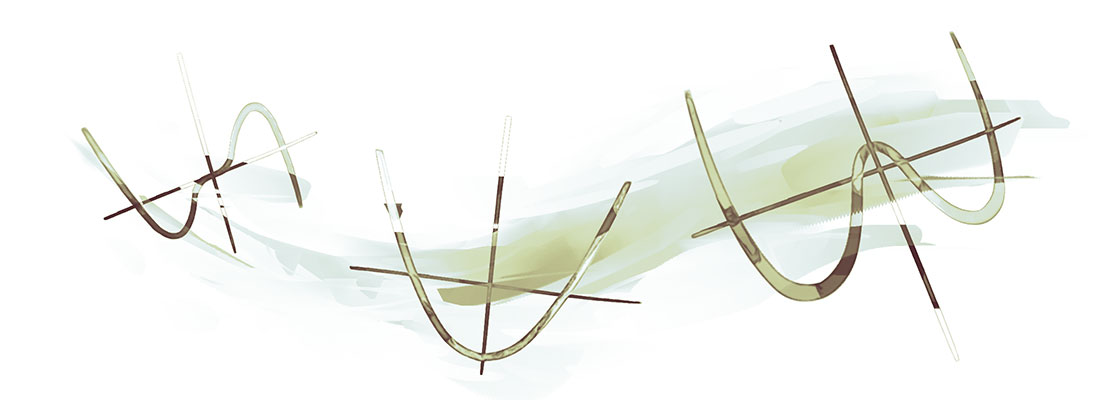
Root Harvest
The Langlands program is a sprawling research vision that begins with a simple concern: finding solutions to polynomial equations like x2 − 2 = 0 and x4 − 10x2 + 22 = 0. Solving them means finding the “roots” of the polynomial — the values of x that make the polynomial equal zero (x = $latex \pm \sqrt{2}$ for the first example, and x = $latex \pm \sqrt{5 \pm \sqrt{3}}$ for the second).
By the 1500s mathematicians had discovered tidy formulas for calculating the roots of polynomials whose highest powers are 2, 3 or 4. They then searched for ways to identify the roots of polynomials with variables raised to the power of 5 and beyond. But in 1832 the young mathematician Évariste Galois discovered the search was fruitless, proving that there are no general methods for calculating the roots of higher-power polynomials.
Galois didn’t stop there, though. In the months before his death in a duel in 1832 at age 20, Galois laid out a new theory of polynomial solutions. Rather than calculating roots exactly — which can’t be done in most cases — he proposed studying the symmetries between roots, which he encoded in a new mathematical object eventually called a Galois group.
In the example x2 − 2, instead of making the roots explicit, the Galois group emphasizes that the two roots (whatever they are) are mirror images of each other as far as the laws of algebra are concerned.
“Mathematicians had to step away from formulas because usually there were no formulas,” said Brian Conrad of Stanford University. “Computing a Galois group is some measure of computing the relations among the roots.”
Throughout the 20th century mathematicians devised new ways of studying Galois groups. One main strategy involved creating a dictionary translating between the groups and other objects — often functions coming from calculus — and investigating those as a proxy for working with Galois groups directly. This is the basic premise of the Langlands program, which is a broad vision for investigating Galois groups — and really polynomials — through these types of translations.
The Langlands program began in 1967, when its namesake, Robert Langlands, wrote a letter to a famed mathematician named André Weil. Langlands proposed that there should be a way of matching every Galois group with an object called an automorphic form. While Galois groups arise in algebra (reflecting the way you use algebra to solve equations), automorphic forms come from a very different branch of mathematics called analysis, which is an enhanced form of calculus. Mathematical advances from the first half of the 20th century had identified enough similarities between the two to make Langlands suspect a more thorough link.
“It’s remarkable that these objects of a very different nature somehow communicate with each other,” said Ana Caraiani of Imperial College London.
If mathematicians could prove what came to be called the Langlands correspondence, they could confidently investigate all polynomials using the powerful tools of calculus. The conjectured relationship is so fundamental that its solution may also touch on many of the biggest open problems in number theory, including three of the million-dollar Millennium Prize problems: the Riemann hypothesis, the BSD conjecture and the Hodge conjecture.
Given the stakes, generations of mathematicians have been motivated to join the effort, developing Langlands’ initial conjectures into what is almost certainly the largest, most expansive project in the field today.
“The Langlands program is a network of conjectures that touch upon almost every area of pure mathematics,” said Caraiani.
Numbers From Shapes
Beginning in the early 1980s Vladimir Drinfeld and later Alexander Beilinson proposed that there should be a way to interpret Langlands’ conjectures in geometric terms. The translation between numbers and geometry is often difficult, but when it works it can crack problems wide open.
To take just one example, a basic question about a number is whether it has a repeated prime factor. The number 12 does: It factors into 2 × 2 × 3, with the 2 occurring twice. The number 15 does not (it factors into 3 × 5).
In general, there’s no quick way of knowing whether a number has a repeated factor. But there is an analogous geometric problem which is much easier.
Polynomials have many of the same properties as numbers: You can add, subtract, multiply and divide them. There’s even a notion of what it means for a polynomial to be “prime.” But unlike numbers, polynomials have a clear geometric guise. You can graph their solutions and study the graphs to gain insights about them.
For instance, if the graph is tangent to the x-axis at any point, you can deduce that the polynomial has a repeated factor (indicated at exactly the point of tangency). It’s just one example of how a murky arithmetic question acquires a visual meaning once converted into its analogue for polynomials.
“You can graph polynomials. You can’t graph a number. And when you graph a [polynomial] it gives you ideas,” said Conrad. “With a number you just have the number.”
The “geometric” Langlands program, as it came to be called, aimed to find geometric objects with properties that could stand in for the Galois groups and automorphic forms in Langlands’ conjectures. Proving an analogous correspondence in this new setting by using geometric tools could give mathematicians more confidence in the original Langlands conjectures and perhaps suggest useful ways of thinking about them. It was a nice vision, but also a somewhat airy one — a bit like saying you could cross the universe if you only had a time machine.
“Making geometric objects that serve a similar role in the setting of numbers is a much more difficult thing to do,” said Conrad.
So for decades the geometric Langlands program remained at a distance from the original one. The two were animated by the same goal, but they involved such fundamentally different objects that there was no real way to make them talk to each other.
“The arithmetic people sort of looked bemused by [the geometric Langlands program]. They said it’s fine and good, but completely unrelated to our concern,” said Kaletha.
The new work from Scholze and Fargues, however, finally fulfills the hopes pinned on the geometric Langlands program — by finding the first shape whose properties communicate directly with Langlands’ original concerns.
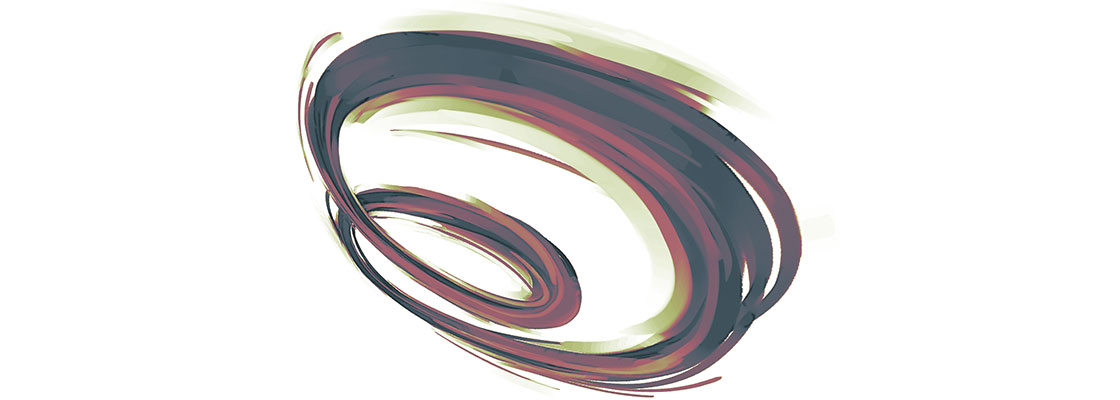
Scholze’s Tour de Force
In September 2014, Scholze was teaching a special course at the University of California, Berkeley. Despite being only 26, he was already a legend in the mathematics world. Two years earlier he had completed his dissertation, in which he articulated a new geometric theory based on objects he’d invented called perfectoid spaces. He then used this framework to solve part of a problem in number theory called the weight-monodromy conjecture.
But more important than the particular result was the sense of possibility surrounding it — there was no telling how many other questions in mathematics might yield to this incisive new perspective.
The topic of Scholze’s course was an even more expansive version of his theory of perfectoid spaces. Mathematicians filled the seats in the small seminar room, lined up along the walls and spilled out into the hallway to hear him talk.
“Everyone wanted to be there because we knew this was revolutionary stuff,” said David Ben-Zvi of the University of Texas, Austin.
Scholze’s theory was based on special number systems called the p-adics. The “p” in p-adic stands for “prime,” as in prime numbers. For each prime, there is a unique p-adic number system: the 2-adics, the 3-adics, the 5-adics and so on. P-adic numbers have been a central tool in mathematics for over a century. They’re useful as more manageable number systems in which to investigate questions that occur back in the rational numbers (numbers that can be written as a ratio of positive or negative whole numbers), which are unwieldy by comparison.
The virtue of p-adic numbers is that they’re each based on just one single prime. This makes them more straightforward, with more obvious structure, than the rationals, which have an infinitude of primes with no obvious pattern among them. Mathematicians often try to understand basic questions about numbers in the p-adics first, and then take those lessons back to their investigation of the rationals.
“The p-adic numbers are a small window into the rational numbers,” said Kaletha.
All number systems have a geometric form — the real numbers, for instance, take the form of a line. Scholze’s perfectoid spaces gave a new and more useful geometric form to the p-adic numbers. This enhanced geometry made the p-adics, as seen through his perfectoid spaces, an even more effective way to probe basic number-theoretic phenomena, like questions about the solutions of polynomial equations.
“He reimagined the p-adic world and made it into geometry,” said Ben-Zvi. “Because they’re so fundamental, this leads to lots and lots of successes.”
In his Berkeley course, Scholze presented a more general version of his theory of perfectoid spaces, built on even newer objects he’d devised called diamonds. The theory promised to further enlarge the uses of the p-adic numbers. Yet at the time Scholze began teaching, he had not even finished working it out.
“He was giving the course as he was developing the theory. He was coming up with ideas in the evening and presenting them fresh out of his mind in the morning,” said Kaletha.
It was a virtuosic display, and one of the people in the room to hear it was Laurent Fargues.
Have Curve, Will Travel
At the same time Scholze was giving his lectures, Fargues was attending a special semester at the Mathematical Sciences Research Institute just up the hill from the Berkeley campus. He had thought a lot about the p-adic numbers, too. For the past decade he’d worked with Jean-Marc Fontaine in an area of math called p-adic Hodge theory, which focuses on basic arithmetic questions about these numbers. During that time, he and Fontaine had come up with a new geometric object of their own. It was a curve — the Fargues-Fontaine curve — whose points each represented a version of an important object called a p-adic ring.
As originally conceived, it was a narrowly useful tool in a technical part of mathematics, not something likely to shake up the entire field.
“It’s an organizing principle in p-adic Hodge theory, that’s how I think of it. It was impossible for me to keep track of all these rings before this curve came up,” said Caraiani.
But as Fargues sat listening to Scholze, he envisioned an even greater role for the curve in mathematics. The never-realized goal of the geometric Langlands program was to find a geometric object that encoded answers to questions in number theory. Fargues perceived how his curve, merged with Scholze’s p-adic geometry, could serve exactly that role. Around mid-semester he pulled Scholze aside and shared his nascent plan. Scholze was skeptical.
“He mentioned this idea to me over a coffee break at MSRI,” said Scholze. “It was not a very long conversation. At first I thought it couldn’t be good.”
But they had more conversations, and Scholze soon realized the approach might work after all. On December 5, as the semester wound down, Fargues gave a lecture at MSRI in which he introduced a new vision for the geometric Langlands program. He proposed that it should be possible to redefine the Fargues-Fontaine curve in terms of Scholze’s p-adic geometry, and then use that redefined object to prove a version of the Langlands correspondence. Fargues’ proposal was a final, unexpected turn in what had already been a thrilling season of mathematics.
“It was like this grand finale of this semester. I remember just being in shock,” said Ben-Zvi.
A Local Correspondence
The original Langlands conjectures are about matching representations of the Galois groups of the rational numbers with automorphic forms. The p-adics are a different number system, and there is a version of the Langlands conjectures there, too. (Both are still separate from the geometric Langlands program.) It also involves a kind of matching, though in this case it’s between representations of the Galois group of the p-adic numbers and representations of p-adic groups.
While their objects are different, the spirit of the two conjectures is the same: to study solutions to polynomials — in terms of rational numbers in one case and p-adic numbers in the other — by relating two seemingly unrelated kinds of objects. Mathematicians refer to the Langlands conjecture for rational numbers as the “global” Langlands correspondence, because the rationals contain all the primes, and the version for p-adics as the “local” Langlands correspondence, since p-adic number systems deal with one prime at a time.
In his December lecture at MSRI, Fargues proposed proving the local Langlands conjecture using the geometry of the Fargues-Fontaine curve. But because he and Fontaine had developed the curve for a completely different and more limited task, their definition required more powerful geometry that could provide the structure and complexity the curve would ultimately need to support these enlarged plans.
The situation was similar to how you could arrive at a three-sided shape that’s independent of any particular geometric theory, but if you combine that shape with the theory of Euclidean geometry, suddenly it takes on a richer life: You get trigonometry, the Pythagorean theorem and well-defined notions of symmetry. It becomes a fully fledged triangle.
“[Fargues] was taking the idea of the curve and using the powerful geometry that Scholze developed to flesh out that idea,” said Kaletha. “That allows you to formally state the beautiful properties of the curve.”
Fargues’ strategy came to be known as the “geometrization of the local Langlands correspondence.” But at the time he made it, existing mathematics didn’t have the tools he needed to carry it out, and new geometric theories don’t come along every day. Luckily, history was on his side.
“[Fargues’ conjecture] was a bold idea because Fargues needed geometry that didn’t exist. But as it turned out Scholze at that very moment was developing it,” said Kaletha.
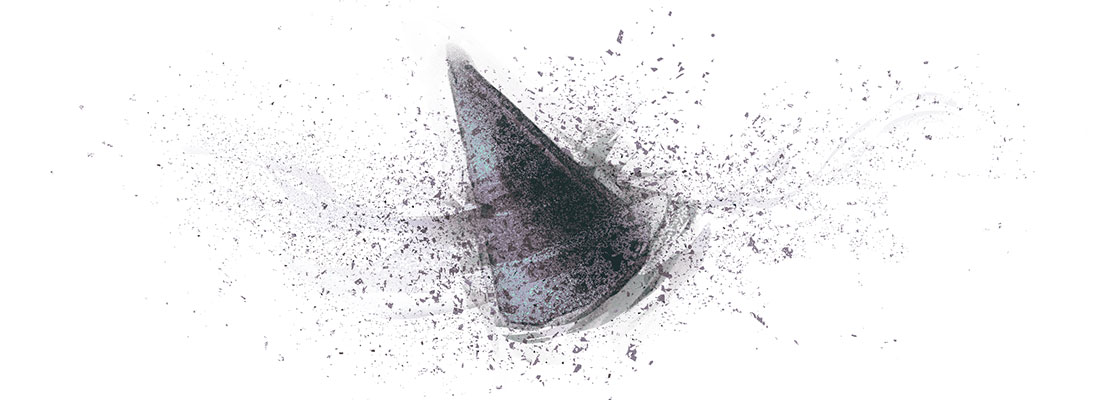
Foundation Building
Following their time together in Berkeley, Fargues and Scholze spent the next seven years establishing a geometric theory that would allow them to reconstruct the Fargues-Fontaine curve in a form suitable for their plans.
“In 2014 it was basically already clear what the picture should be and how everything should fit together. It was just that everything was completely ill-defined. There were no foundations in place to talk about any of this,” said Scholze.
The work took place in several stages. In 2017 Scholze completed a paper called “Étale Cohomology of Diamonds,” which formalized many of the most important ideas he had introduced during his Berkeley lectures. He combined that paper with another massive work that he and co-author Dustin Clausen of the University of Copenhagen released as a series of lectures in 2020. That material — all 352 pages of it — was needed to establish a foundation for a few particular points that had come up in Scholze’s work on diamonds.
“Scholze had to come up with a whole other theory which was just there to take care of certain technical issues that came up on the last three pages of his [2017] paper,” said Kaletha.
Altogether, these and other papers allowed Fargues and Scholze to devise an entirely new way of defining a geometric object. Imagine that you start with an unorganized collection of points — a “cloud of dust,” in Scholze’s words — that you want to glue together in just the right way to assemble the object you’re looking for. The theory Fargues and Scholze developed provides exact mathematical directions for performing that gluing and certifies that, in the end, you will get the Fargues-Fontaine curve. And this time, it’s defined in just the right way for the task at hand — addressing the local Langlands correspondence.
“That’s technically the only way we can get our hands on it,” said Scholze. “You have to rebuild a lot of foundations of geometry in this kind of framework, and it was very surprising to me that it is possible.”
After they’d defined the Fargues-Fontaine curve, Fargues and Scholze embarked on the next stage of their journey: equipping it with the features necessary to prove a correspondence between representations of Galois groups and representations of p-adic groups.
To understand these features, let’s first consider a simpler geometric object, like a circle. At every point on the circle it’s possible to position a line that’s tangent to the shape at exactly that point. Every point has a unique tangent line. You can collect all those many lines together into an auxiliary geometric object, called the tangent bundle, that’s associated to the underlying geometric object, the circle.
In their new work, Fargues and Scholze do something similar for the Fargues-Fontaine curve. But instead of tangent planes and bundles, they define ways of constructing many more complicated geometric objects. One example, called sheaves, can be associated naturally to points on the Fargues-Fontaine curve the way tangent lines can be associated to points on a circle.
Sheaves were substantially developed in the 1950s by Alexander Grothendieck, and they keep track of how algebraic and geometric features of the underlying geometric object interact with each other. For decades, mathematicians have suspected they might be the best objects to focus on in the geometric Langlands program.
“You reinterpret the theory of representations of Galois groups in terms of sheaves,” said Conrad.
There are local and global versions of the geometric Langlands program, just as there are for the original one. Questions about sheaves relate to the global geometric program, which Fargues suspected could connect to the local Langlands correspondence. The issue was that mathematicians didn’t have the right kinds of sheaves defined on the right kind of geometric object to carry the day. Now Fargues and Scholze have provided them, via the Fargues-Fontaine curve.
The End of the Beginning
Specifically, they came up with two different kinds: Coherent sheaves correspond to representations of p-adic groups, and étale sheaves to representations of Galois groups. In their new paper, Fargues and Scholze prove that there’s always a way to match a coherent sheaf with an étale sheaf, and as a result there’s always a way to match a representation of a p-adic group with a representation of a Galois group.
In this way, they finally proved one direction of the local Langlands correspondence. But the other direction remains an open question.
“It gives you one direction, how to go from a representation of a p-adic group to a representation of a Galois group, but doesn’t tell you how to go back,” said Scholze.
The work is one of the biggest advances so far on the Langlands program — often mentioned in the same breath as work by Vincent Lafforgue of the Fourier Institute in Grenoble, France, on a different aspect of the Langlands correspondence in 2018. It’s also the most tangible evidence yet that earlier mathematicians weren’t foolish to attempt the Langlands program by geometric means.
“These things are a great vindication for the work people were doing in geometric Langlands for decades,” said Ben-Zvi.
For mathematics as a whole, there’s a sense of awe and possibility in the reception of the new work: awe at the way the theory of p-adic geometry Scholze has been building since graduate school manifests in the Fargues-Fontaine curve, and possibility because that curve opens entirely new and unexplored dimensions of the Langlands program.
“It’s really changed everything. These last five or eight years, they have really changed the whole field,” said Viehmann.
The clear next step is to nail down both sides of the local Langlands correspondence — to prove that it’s a two-way street, rather than the one-way road Fargues and Scholze have paved so far.
Beyond that, there’s the global Langlands correspondence itself. There’s no obvious way to translate Fargues and Scholze’s geometry of the p-adic numbers into corresponding constructions for the rational numbers. But it’s also impossible to look at this new work and not wonder if there might be a way.
“It’s a direction I’m really hoping to head into,” Scholze said.
Correction: July 26, 2021
Alexander Grothendieck was not the first to define sheaves, although he did substantially develop them. The article has been revised accordingly.
